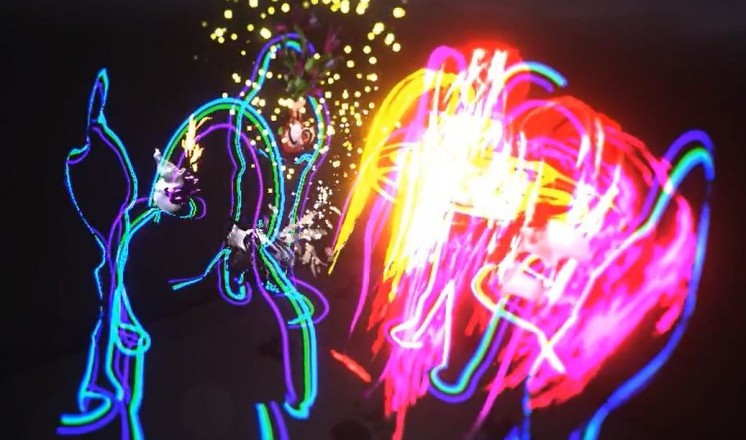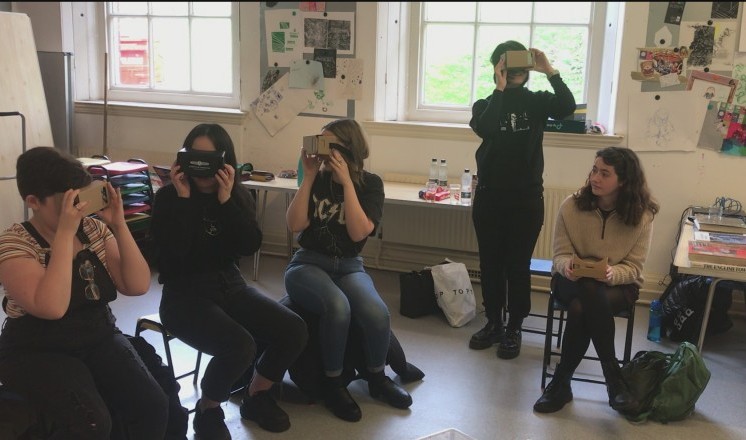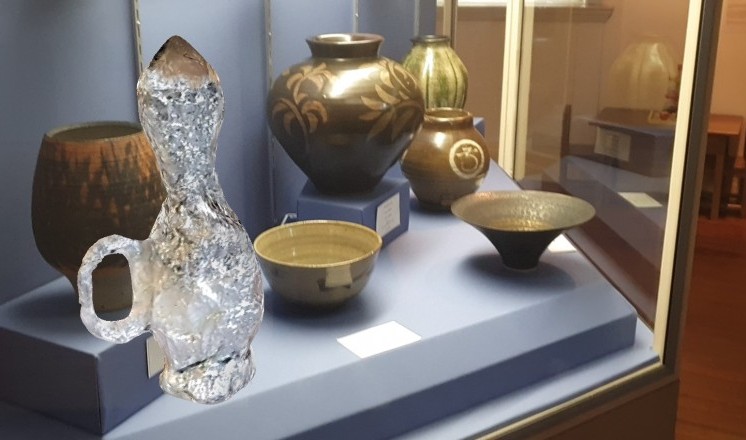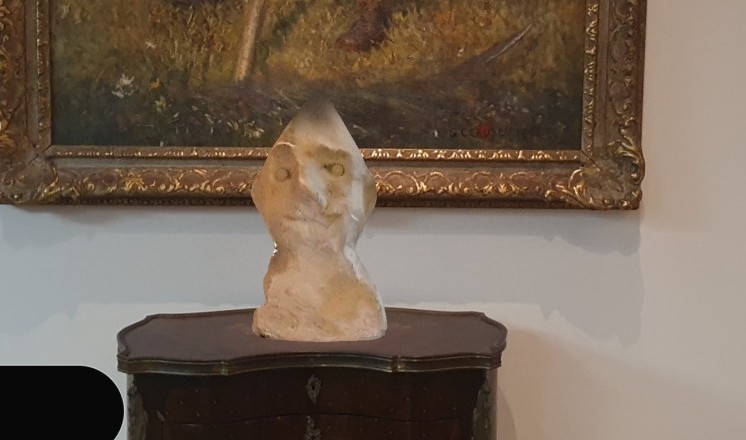The Creative Collective, Term 2: VR, AR and artists workshops
RSS FeedThe Creative Collective is a young people's group passionate about art and culture, who meet weekly at The Collection and Usher Gallery.
With the second term of the Creative Collective recently coming to an end, several members of the group have provided a reflective and insightful perspective on some workshops they participated in as part of the group. If you are interested in finding out more about the Creative Collective, visit our section on Getting Involved
Workshop with Artist Annabel McCourt in September 2019
By Zendon Page
A fellow member of the Creative Collective and I were fortunate enough to be able to take part in a workshop with Annabel McCourt which took place before she had her solo exhibition 'Electric Fence' at the Usher Gallery. During this workshop she discussed her practice and motivations behind her work. This mainly surrounded her ‘Electric Fence’ exhibition for which she was still in the process of deciding how she would display within our gallery space. Annabel introduced us to her previous work, including ‘Suffering Arcadia’ and the ‘MAGA Grabber’ before familiarising us with the ‘Electric Fence’ and explaining how it is up to the viewer to decide how they’d like to interpret the piece. My friend and I had the opportunity to decide what the fence could mean to us, leading to a discussion exploring themes of; race, gender, sexuality and belonging.
For the second part of the workshop, we decided to get practical and use Annabel’s recording equipment in order to make a contribution to her project. My friend assisted with the sound equipment and we recorded a few discussions with Annabel surrounding our interpretations of the fence and the importance of such themes in our lives. Furthermore, with a make-shift backdrop, Annabel’s studio lights and camera, we finished our contribution with a short video. This enabled us to put a face to the voice of our previous recordings. This format is one that Annabel has used with other groups of young people. In my opinion, this is incredibly effective in allowing the viewer to fully grasp the feelings and message of the person in front of the camera.
Virtual Reality Workshop: VR Introduction, Model Making and the Scanning Process with Derby QUAD on 7th March 2020
By Eloise Pryor
The Virtual Reality (VR) workshop was a really valuable experience, where the group was able to gain a lot of information about some immersive technologies. Whilst not a ‘new’ technology, VR and Augmented Reality (AR) have only fairly recently become widely accessible to regular consumers; through the games industry and smartphone apps to name a couple.
We began the VR workshop with a presentation all about VR and AR; the history, applications and also what we would be doing during the entire day of the workshop. We got to test out cardboard VR eyepieces, which just used our phone and an app to view an exhibition in a gallery. This started to give us an idea of what can be achieved with VR in galleries, which was an exciting possibility.
To use VR to its full potential, we would need some models to import into a VR-space. We made models, some using clay and others using tin-foil and wire. Once we had made our models we were ready to test the capabilities of the scanning technology and see which materials worked best for scanning. We scanned our objects using cameras on tablets and smartphones through an app called Qlone, this created our real object into a file format that the VR software could understand. The files were then exported to a computer and set up in a virtual gallery, ready for us to view through the VR headset. Before the workshop, I didn’t really have a thorough understanding of the possibilities of VR, but left feeling like I had definitely learned a lot!
VR Workshop: Tilt brush and Creativity on 7th March 2020
By Deborah Ng
In the Virtual Reality (VR) workshop, we were given the chance to experience art making with a full VR kit and the program Tilt Brush. When we put on the VR headset, our minds became immersed within the virtual reality world. Our vision became submerged with what was displayed on the headset screen, as if our soul was really living in the digital world that was awaiting us to decorate it. We were only given a couple hours to play around with the program, but it was still an absolutely valuable experience.
At the beginning of this experience using Tilt Brush, we got familiar with the program by virtually doodling on and around a bust sculpture. Later, we were given the chance to create an original group work. With the help of John Whall, the guest facilitator who is a Digital Participation Officer at Quad (Derby), we were able to express our personality to make the virtual canvas much more vivid.
Many of us were very keen on experimenting with 'painting' in the three-dimensional virtual space and exploring such a creative idea has been made so convenient in Tilt Brush. We looked at how other artists explored the relationship of space, their art and themselves by painting in VR. One of the artist's used VR to make fantasy come true with the aid of augmented reality (AR), another one used VR as an immersive tool for providing a simulating emotional experience to deliver their intended message.
It was an insightful session where I gained an understanding in the potential of how current immersive technology can be applied in contemporary art and cultural heritage. It has inspired me, an art and cultural enthusiast to explore more possibilities of how VR can be applied in my field of work.
Augmented Reality in the Gallery
By Eleanor Ball
As part of the Virtual Reality (VR) workshop day the Creative Collective learnt about the different levels of reality mixing virtual with real. Augmented Reality (AR) places virtual object within a real space in real time. When learning about this the Creative Collective created art pieces with basic materials such as; clay, tinfoil and wire. Then we scanned these objects using VR applications to do a 3d scan of the object. Often this created a new version of the object that was a technological imitation of the real object. This created interesting results especially the objects made with tinfoil as the technology found the light reflections confusing, creating new shapes within the object.
However, as a group we really enjoyed these glitches and the unpredictability of the scan itself. It played around with the idea of the Uncanny Theory as well as following with our key theme of appropriation which was integral to our work. It also brought up questions of authorship within the artwork. Although we had all created our objects, the technology had appropriated these and created something new enough to claim as its own. In this process it felt as if I was the material and the technology became the artist. One might think this would be scary to acknowledge, however I found it freeing not having to make artistic decisions and allowing the work to breathe its own life.
After the scans were complete, we were then able to place the objects around the gallery enlarging them and shrinking them in the space. It was also possible to place them onto artworks and objects around the space. At first it was humorous to place a distorted vase next to The Hunter and The Dog statue, after a while I began to question the artists intentions with the work. When exhibiting work it is common to navigate this issue, carefully considering how the artist wishes the work to be shown. However, when mixing the virtual with the real; augmented reality creates a new realm for exploration surrounding this topic. It is intriguing to investigate the development of work and how to show it without compromising the artist's intent. It is through augmented reality that we can explore how to develop the real, appropriating images and testing the limits of technology.
Augmented Reality in the Gallery
By Ka Ying Fong
Bringing in digital technology into museums and galleries is nothing new, and Augmented Reality (AR) is one technology that I think will be good to use more in galleries.
Before attending the workshops at the Usher Gallery as part of the Creative Collective, I have been to different exhibitions and museums that are using AR. For example in Mademoiselle Prive Hong Kong by Chanel, you can watch an animation about Coco Chanel’s design studio through the camera in the mobile app, when you use it in front of the displaying studio door. However, the excitement and audience engagement was not as good as other activities in the exhibition.
During the virtual reality workshop, we scanned our items and had the opportunity to put them into the gallery space by using AR. The scan might not be perfect, but it was still very exciting to see my little artwork being transported into the gallery space, even if it was just in the virtual world.
In AR you can place your art object somewhere that might not usually be physically possible, for example; hanging on the ceiling, extruding from the wall or inside the display case with some other artworks. By using AR in this way for the general public, it could simulate the feeling of displaying your own artwork in a museum. Imagine how it would feel to display your artwork using AR in your local gallery or perhaps in a world-renowned museum such as the Louvre Museum or Tate Modern.
Apart from putting objects into gallery spaces, AR could also have other uses in museums and galleries. There are some physical artworks or artefacts that are not complete for various reasons, which you could potentially use AR to be able to see what the completed product may look like. I think this would be a good and educational way for people to use their mobile devices in museums and galleries.
Comments
There aren’t any comments for this blog yet







